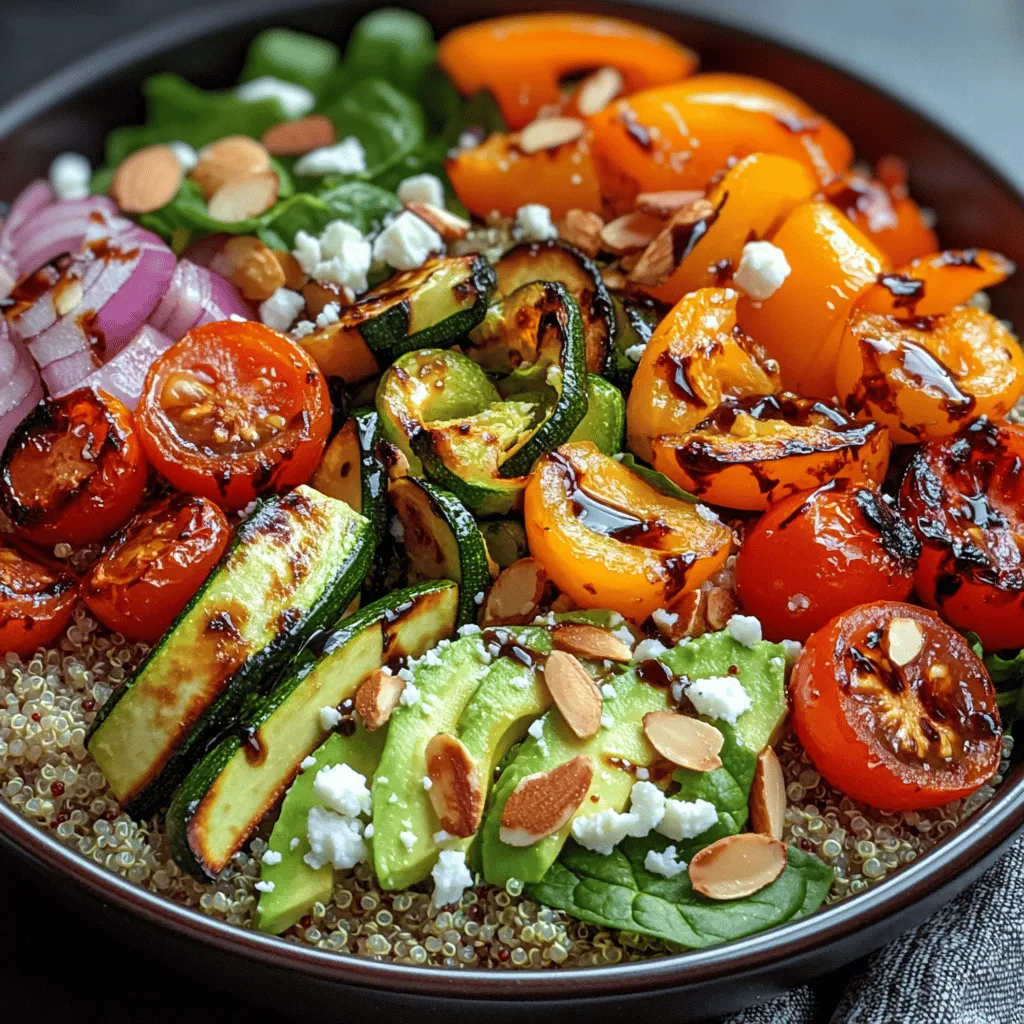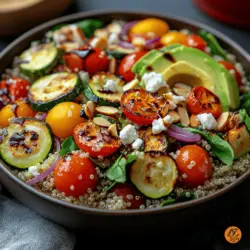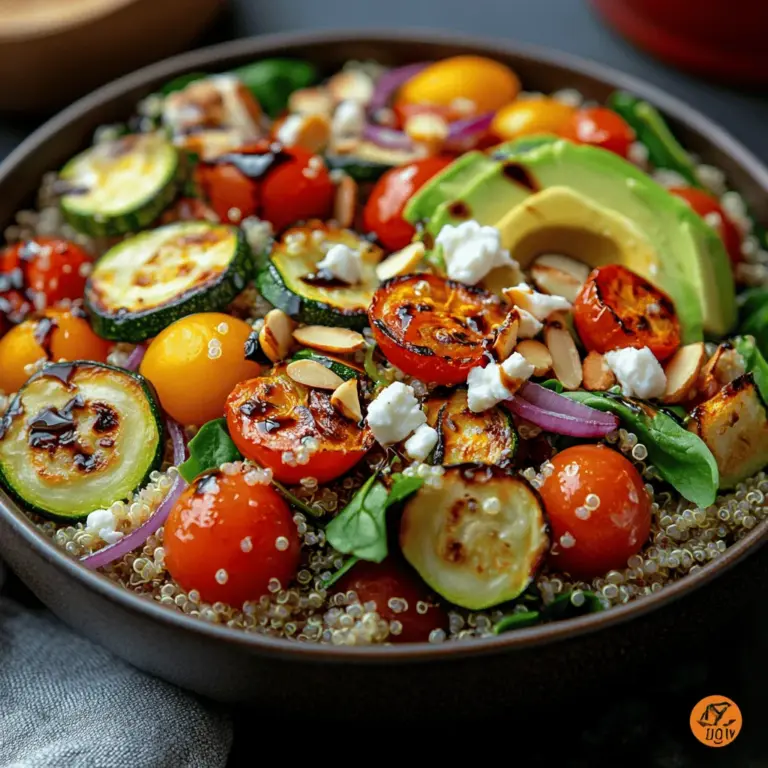Quinoa and Roasted Veggie Power Bowls: A Healthy Culinary Trend
In recent years, power bowls have surged in popularity as a staple in health-conscious diets. These nutrient-packed meals, often brimming with vibrant vegetables, hearty grains, and protein-rich ingredients, have captured the attention of food enthusiasts and health advocates alike. Among the various power bowl recipes, quinoa and roasted veggie power bowls stand out for their exceptional balance of flavors, textures, and nutritional benefits.
Quinoa, a grain-like seed that has been cultivated for thousands of years, serves as a fantastic base for these power bowls. Known for its high protein content, quinoa is a complete protein, meaning it contains all nine essential amino acids that the body cannot produce on its own. It’s also rich in fiber, vitamins, and minerals, making it a perfect addition to a balanced diet. Coupled with an array of roasted vegetables—including zucchini, bell peppers, cherry tomatoes, and red onions—this dish not only satisfies the palate but also promotes overall health.
Incorporating plant-based meals like quinoa and roasted veggie power bowls into your daily diet is essential for numerous reasons. Plant-based diets have been linked to lower risks of chronic diseases, improved digestion, and enhanced energy levels. By focusing on whole, unprocessed foods, you can nourish your body while enjoying a diverse range of flavors and textures. This recipe not only meets the needs of health-conscious eaters but also appeals to those seeking delicious, vibrant meals that can easily be customized to suit individual preferences.
Understanding the Ingredients
Quinoa: A Nutritional Powerhouse
Quinoa is often referred to as a superfood, and for good reason. This ancient grain is gluten-free and boasts a remarkable nutritional profile. A single cup of cooked quinoa contains approximately 8 grams of protein and 5 grams of fiber, making it an excellent choice for those looking to increase their protein intake without relying on animal products. Additionally, quinoa is rich in important nutrients such as magnesium, phosphorus, manganese, and folate, all of which contribute to various bodily functions, including bone health and energy production.
One of the most appealing aspects of quinoa is its versatility. It can be used in salads, soups, and, of course, power bowls. Its slightly nutty flavor and fluffy texture create a satisfying base that pairs beautifully with a variety of toppings and ingredients.
The Role of Vegetables in a Balanced Diet
Vegetables are key players in a healthy diet, providing essential vitamins, minerals, and antioxidants. The specific vegetables chosen for this power bowl—zucchini, bell peppers, cherry tomatoes, and red onions—each offer unique health benefits:
– Zucchini: Low in calories and high in vitamin C, zucchini is also a great source of potassium, which helps regulate blood pressure.
– Bell Peppers: These colorful veggies are packed with vitamins A and C, as well as a range of antioxidants that support immune health.
– Cherry Tomatoes: Rich in lycopene, an antioxidant linked to numerous health benefits, cherry tomatoes are also a great source of vitamins C and K.
– Red Onions: Known for their anti-inflammatory properties, red onions are rich in quercetin, which may help reduce blood pressure and improve heart health.
Combining these vegetables not only enhances the power bowl’s nutritional profile but also creates a vibrant, visually appealing dish that is sure to please any palate.
Toppings: Elevating the Nutritional Value
To further enhance the power bowl experience, thoughtful toppings can be added. Avocado, spinach, feta cheese, and nuts are popular choices that provide additional flavors and nutrients:
– Avocado: Packed with healthy fats, fiber, and potassium, avocado adds creaminess and helps you feel full longer. Its monounsaturated fats are also beneficial for heart health.
– Spinach: This leafy green is a powerhouse of nutrients, including iron and calcium, and is known for its anti-inflammatory properties.
– Feta Cheese: Offering a tangy flavor, feta cheese provides protein and calcium, making it a delicious addition to the bowl.
– Nuts: Chopped nuts, such as almonds or walnuts, add a satisfying crunch and healthy fats, as well as protein and fiber.
Incorporating these toppings not only enhances the flavor and texture of the power bowl but also boosts its overall nutritional value, making each bite a healthful delight.
Preparing the Quinoa
Cooking quinoa may seem straightforward, but there are a few key steps to ensure it turns out perfectly every time. Follow these instructions for a fluffy and flavorful base for your power bowl:
1. Rinse the Quinoa: Begin by measuring out your desired amount of quinoa. Rinse it thoroughly under cold water in a fine-mesh strainer. This step is crucial, as it removes the natural coating called saponin, which can impart a bitter taste if not washed away.
2. Cook in Vegetable Broth: For added flavor, cook the rinsed quinoa in vegetable broth instead of water. Use a ratio of 1 cup of quinoa to 2 cups of broth. Bring the mixture to a boil, then reduce the heat to low and cover the pot. Let it simmer for about 15 minutes, or until the quinoa has absorbed the liquid and appears fluffy.
3. Season for Flavor: Once cooked, fluff the quinoa with a fork and season it to taste. A drizzle of olive oil, a squeeze of lemon juice, and a pinch of salt can elevate the flavor profile, making it a delectable base for your power bowl.
4. Set Aside to Cool: Allow the quinoa to cool slightly before assembling your power bowl. This will help maintain the integrity of the toppings and ensure that the dish remains fresh and vibrant.
Roasting the Vegetables
Roasting vegetables is one of the best techniques to enhance their natural flavors and textures. The high heat caramelizes the sugars in the veggies, resulting in a deliciously sweet and savory profile. Here’s how to roast your selection of vegetables for the power bowl:
1. Preheat the Oven: Start by preheating your oven to 425°F (220°C). A hot oven is essential for achieving that perfect caramelization.
2. Prepare the Vegetables: Wash and chop the zucchini, bell peppers, cherry tomatoes, and red onions into bite-sized pieces. Aim for uniform sizes to ensure even cooking.
3. Season Generously: Place the chopped vegetables on a large baking sheet lined with parchment paper. Drizzle with olive oil and season with salt, pepper, and any other preferred herbs or spices, such as garlic powder or Italian seasoning. Toss everything together to ensure an even coating.
4. Roast to Perfection: Spread the vegetables in a single layer on the baking sheet. Roast in the preheated oven for about 20-25 minutes, stirring halfway through to promote even cooking. The vegetables should be tender and slightly caramelized when done.
5. Cool Before Assembling: Once roasted, remove the vegetables from the oven and let them cool slightly before adding them to your power bowl. This will help to keep the textures distinct and prevent the quinoa from becoming mushy.
With the quinoa cooked and the vegetables roasted to perfection, you are well on your way to creating a nourishing and satisfying quinoa and roasted veggie power bowl. In the next section, we will explore how to assemble the bowl, including the best combinations of toppings and dressings to elevate your meal further.

Importance of Oven Temperature and Timing for Optimal Roasting Results
Achieving perfectly roasted vegetables is an art that hinges on both oven temperature and timing. For the best results with your Quinoa and Roasted Veggie Power Bowls, preheat your oven to 425°F (220°C). This high temperature allows the vegetables to caramelize beautifully while retaining their freshness. Depending on the type of vegetables you choose, roasting times may vary. Generally, root vegetables like carrots and sweet potatoes will take around 25-30 minutes, while softer vegetables like zucchini and bell peppers may only need 15-20 minutes.
To ensure even roasting, arrange the vegetables in a single layer on your baking sheet, leaving some space between them. Overcrowding can lead to steaming rather than roasting, preventing that coveted crispy texture. Flip the vegetables halfway through cooking for an even golden brown color. A little patience during this process will yield vibrant, flavorful veggies that elevate your power bowl.
Assembling the Power Bowls
Step-by-Step Guide to Layering the Ingredients
Now that your quinoa is cooked and your vegetables are beautifully roasted, the fun part begins—assembling your power bowl. Follow these steps for an appealing and delicious presentation:
1. Base Layer: Start with a generous scoop of quinoa at the bottom of your bowl. This will act as the foundation, providing a hearty texture and nutty flavor.
2. Vegetable Layer: Next, artfully arrange your roasted veggies on top of the quinoa. Use a variety of colors and shapes to create visual interest. For instance, place bright orange carrots alongside deep green kale and purple beets.
3. Protein Addition: If you’re looking to enhance the protein content, add a layer of your choice of protein. Grilled chicken, chickpeas, or tofu work beautifully here. Scatter them over the veggies for both texture and taste.
4. Fresh Greens: Add a handful of fresh greens like spinach or arugula for a crisp and refreshing contrast. The greens will provide a burst of flavor and nutritional benefits.
5. Dressing or Sauce: Drizzle your favorite dressing over the top. A simple lemon vinaigrette or tahini dressing can add a zesty finish.
6. Garnish: Finally, sprinkle with toppings like seeds (pumpkin or sunflower), nuts (almonds or walnuts), or fresh herbs (cilantro or parsley) for an extra crunch and flavor boost.
Nutritional Impact of Each Layer in the Bowl
Each layer in your power bowl not only adds flavor but also contributes to your overall health.
– Quinoa: A complete protein, quinoa contains all nine essential amino acids. It is high in fiber and packed with vitamins and minerals like magnesium and iron, making it a fantastic base for any meal.
– Roasted Vegetables: Depending on the vegetables you choose, you can incorporate a wide range of nutrients. For example, bell peppers are rich in vitamin C, while kale is loaded with antioxidants. Roasting enhances their natural sweetness and makes them more enjoyable to eat.
– Protein Source: Adding grilled chicken, chickpeas, or tofu boosts the protein content of your meal, supporting muscle repair and promoting satiety.
– Fresh Greens: Leafy greens are low in calories but high in vitamins A, C, and K, as well as folate. They improve digestion and can help reduce the risk of chronic diseases.
– Dressings and Toppings: Dressings can be a good source of healthy fats, especially if you use olive oil or avocado. Nuts and seeds add crunch and are packed with omega-3 fatty acids, which are beneficial for heart health.
Customizing Bowls with Different Vegetables or Proteins
The beauty of power bowls lies in their flexibility. You can easily customize your bowls based on seasonal produce or personal preferences. Swap out roasted sweet potatoes for Brussels sprouts, or use farro instead of quinoa for a different texture.
For proteins, consider using beans for a plant-based option, or add a hard-boiled egg for an extra dose of nutrients. You can also try incorporating different sauces, like a spicy peanut sauce, to give your bowls a unique twist. The possibilities are endless, allowing you to create a meal that excites your palate and meets your dietary needs.
Nutritional Benefits of the Power Bowl
Comprehensive Overview of the Health Benefits of Each Main Ingredient
Quinoa and Roasted Veggie Power Bowls are not only delicious but also incredibly nourishing. Here’s a closer look at the health benefits of the main ingredients:
– Quinoa: Known for its high protein content, quinoa is gluten-free, making it an excellent choice for those with gluten sensitivities. It’s also rich in fiber, which aids in digestion and helps maintain stable blood sugar levels.
– Roasted Vegetables: Roasting vegetables enhances their flavors and makes them more palatable. Each vegetable brings its unique set of vitamins and minerals. For instance, carrots are high in beta-carotene, which is vital for eye health, while broccoli is an excellent source of vitamin K.
– Proteins: Whether you opt for animal or plant-based proteins, they are essential for muscle repair and growth, hormone production, and overall health. They also contribute to a feeling of fullness, which can aid in weight management.
– Healthy Fats: The healthy fats found in dressings or toppings like avocados and nuts are crucial for brain health and can reduce inflammation in the body.
Explanation of How This Meal Supports Various Dietary Needs
Quinoa and Roasted Veggie Power Bowls can cater to a wide array of dietary preferences, making them a versatile choice for many:
– Gluten-Free: Quinoa is naturally gluten-free, making this dish suitable for those with celiac disease or gluten intolerance.
– Vegetarian/Vegan: The absence of animal products allows this meal to fit into vegetarian and vegan diets. The inclusion of plant-based proteins like chickpeas or lentils ensures adequate protein intake.
– Low-Calorie Options: By controlling the amount of dressing or toppings, you can easily adjust the calorie content to fit your dietary goals.
Discussion on Portion Sizes and How to Balance the Bowl for an Ideal Meal
Creating a balanced bowl is essential for ensuring you receive adequate nutrients while enjoying your meal. A good rule of thumb is to fill half your bowl with vegetables, a quarter with a protein source, and a quarter with grains like quinoa.
For portion sizes, aim for about 1 cup of cooked quinoa, 1-2 cups of roasted vegetables, and a palm-sized portion of protein. This combination will provide you with the energy you need without leading to overeating. Adjust based on your individual needs and activity levels—you may need more if you have a highly active lifestyle.
Serving Suggestions
Ideas for Serving the Power Bowls: Warm vs. Cold Presentation
One of the appealing features of Quinoa and Roasted Veggie Power Bowls is their versatility in serving temperature. You can enjoy them warm, fresh out of the oven, or cold, making them perfect for meal prep. A warm bowl provides comforting nourishment, while a chilled bowl can be refreshing, especially in the warmer months.
If you choose to serve them cold, allow the roasted vegetables to cool before assembling, or refrigerate the bowl for a few hours. This allows the flavors to meld beautifully and can enhance the overall taste experience.
Potential Pairings with Sauces or Dressings
To elevate your power bowl, consider adding a flavorful dressing or sauce. Here are some suggestions:
– Balsamic Glaze: A drizzle of balsamic glaze adds a sweet and tangy flavor profile that complements the roasted vegetables beautifully.
– Tahini Dressing: Creamy tahini mixed with lemon juice, garlic, and water creates a rich dressing that pairs well with the nuttiness of quinoa.
– Spicy Peanut Sauce: If you’re looking for a kick, try a spicy peanut sauce that can bring an Asian twist to your power bowl.
– Lemon Vinaigrette: A simple mix of olive oil, lemon juice, salt, and pepper can brighten up the flavors of your bowl.
Suggestions for Meal Prep and Storage for Convenience
To make life easier, prepare your power bowl ingredients in advance. Cook a large batch of quinoa and roast a variety of vegetables at the beginning of the week. Store them separately in airtight containers in the fridge.
When you’re ready to eat, simply assemble your bowl with the desired ingredients. This not only saves time but also helps maintain the freshness and quality of each component. Quinoa and roasted vegetables can last in the refrigerator for about 4-5 days, making them ideal for meal prepping.
Conclusion
Quinoa and Roasted Veggie Power Bowls are a powerhouse of nutrients, flavor, and versatility. Their simplicity makes them an excellent choice for busy individuals looking to enjoy a healthy meal without sacrificing taste. These bowls can be customized to suit your preferences, allowing for endless variations and creative combinations.
Encouraging readers to experiment with different vegetables, proteins, and dressings can inspire culinary creativity while promoting a balanced diet. Incorporating such meals into your regular routine can lead to improved health and well-being, making it easy to eat wholesome food that fuels your body.
So, gather your ingredients, roast those veggies, and enjoy your delicious power bowl today!


